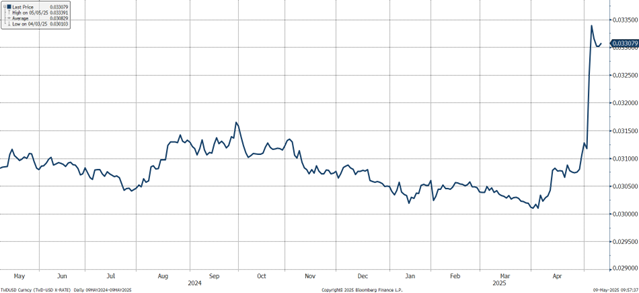Summary
- Canadian dollar weakens significantly after Canada jobs data disappoint.
- Euro currency currently remains below its 1-month average rate of $1.1356.
- Japanese yen softens this week to trade above it is one-month average of 143.54.
- EU is ‘very high’ on U.S. priority list for tariff talks: Navarro.
- Trump: Everyone is cutting except Fed’s Powell.
- 10-Year U.S. Treasury yield remain well behaved between 4.25% and 4.40% this week; currently at 4.35%.
- U.K. pound sterling remains within recent ranges above $1.33 as Pill says Bank of England needs to be ‘alert and agile’ amid uncertainties.
- Mexico peso continues to strengthen trading below 19.50 per one U.S. dollar, sharply stronger than 20.32 average over past month.
- U.S.: Preparation for China talks in Geneva is ‘very promising.’
- President Trump says 80% on China tariffs seems right, up to Bessent.
- Aussie-Kiwi rises as U.S.-China trade talks near.
- Taiwan dollar declined the most in a day since 1988 early in the week.
Noteworthy
- Dollar Trims Weekly Advance; Most G-10 Currencies Rise on Friday
- U.S. – China Trade Talks in Focus This Weekend in Geneva
The U.S. dollar was relatively contained this week perhaps needing more positive trade news to rise further. The U.S. dollar turned lower this morning after rising sharply overnight following a trade deal between the U.S. and the U.K., and the currency might struggle to rise further unless more trade deals are announced, an ING forex analyst said in a note. “U.S. trade developments remain the single biggest driver for the dollar, and the consolidation of bullish dollar momentum requires a constant flow of positive news on trade deals,” the analyst said.
This means more trade deals with key trade partners such as China or Europe could give the currency a boost. The DXY dollar index declined 0.3% to 100.383 after hitting a high of 100.862 in Asian trade.
The U.S. dollar fell on profit-taking after jumping to a one-month high against a basket of currencies and the euro after Thursday’s U.S.-U.K. trade deal. The agreement sparked optimism that this could mark the end of recent anxiety over tariff uncertainty.
The dollar should have room to rise further if more positive news arrives, particularly if U.S. trade deals are announced with China and Europe, says Jefferies analyst Brad Bechtel in a note. “All that negative sentiment on where the U.S. economy was potentially heading is starting to retrace a bit,” he says.
The U.K. pound sterling is expected to strengthen against the euro currency, supported by an improving U.K. trade outlook after trade deals were sealed with the U.S. and India. Investors are now optimistic about talks with the EU, which would have much more meaningful implications for the U.K. and can lend a hand to troubled British finances. Additionally, the Bank of England this week cut interest rates but indicated future rate cuts would likely be gradual. Positive forward guidance from the Bank of England (BoE) also supported the pound sterling.
The euro is steady at 0.8482 pence, having hit a one-month low of 0.8458 pence late Thursday. Traders expect sterling could appreciate to 0.8400 per euro in the coming weeks.
Rising market expectations of a trade deal between China and the U.S. argue for a stronger dollar, says Danske Bank Research’s Jens Peter Sorensen. “Near-term we acknowledge that the environment is supportive of the trimming of dollar shorts,” the director for fixed income and forex research says. The long-term outlook for the dollar is less positive, though. “Longer-term we maintain the view that the last months’ developments all hint at gravitational forces having shifted for EUR/USD,” he says. Danske Bank Research sticks to a buy-on-dips strategy.
The euro’s momentum has stalled for now, but it should pick up when the Federal Reserve starts cutting interest rates later this year, rising to $1.17 by the end of 2025 and to $1.24 by the end of 2026, RBC Capital Markets forecasts.
The euro has fallen since hitting its highest in more than three years at $1.1574 on April 21. RBC says enthusiasm for selling dollars has waned as trade tensions de-escalate. However, U.S. rate cuts should help the euro, while the currency’s share of global reserves will likely increase over the coming years, it says in a note. The euro rises 0.1% to $1.1245, having hit a one-month low of $1.1198 overnight, FactSet data shows.
Finally, Taiwan denies U.S. if seeking a stronger currency in trade talks. On Sunday night, the Taiwan dollar fell the most in a single session since 1988.
Contact Comerica Foreign Exchange
This is not a complete analysis of every material fact regarding any company, industry or security. The information and materials herein have been obtained from sources we consider to be reliable, but Comerica Capital Markets does not warrant, or guarantee, its completeness or accuracy. Materials prepared by Comerica Capital Markets personnel are based on public information. Facts and views presented in this material have not been reviewed by, and may not reflect information known to, professionals in other business areas of Comerica Capital Markets, including investment banking personnel.
The views expressed are those of the author at the time of writing and are subject to change without notice. We do not assume any liability for losses that may result from the reliance by any person upon any such information or opinions. This material has been distributed for general educational/informational purposes only and should not be considered as investment advice or a recommendation for any particular security, strategy or investment product, or as personalized investment advice.



